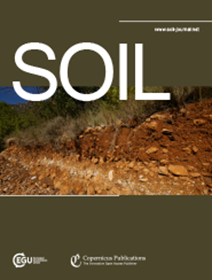改善管理可通过植物-微生物-养分中介增加半干旱草原土壤矿物保护有机碳储量
IF 4.3
2区 农林科学
Q1 SOIL SCIENCE
引用次数: 0
摘要
摘要。半干旱草原土壤有机碳储量受到气候变化和土地退化的双重威胁,影响粮食生产和气候调节。人们提出了改进管理以增加SOC库存并克服这些挑战的建议。然而,在半干旱地区改进管理做法的好处是有问题的。人们对土壤有机碳(SOC)、颗粒(POC)和矿物相关有机碳(MAOC)的功能成分的影响知之甚少,这些成分预计会有不同的响应,以及介导这些响应的途径,如植被和土壤微生物群落的变化。与传统连续放牧相比,分析了轮牧、豆科植物播种和禁牧对地中海林地草地表层土壤SOC、POC和MAOC储量的影响。植物多样性和形态化学性状、土壤肥力和微生物组成的变化也进行了评价。在广泛的环境梯度中,共对9个农场的188个地块进行了采样。资源获取性高、富氮少、木质化程度低的植物群落、较高的土壤微生物生物量和较低的Gram+/Gram-比值、较高的土壤肥力与较高的有机碳储量相关,对POC和MAOC的影响相似。与连续放牧相比,轮牧增加了MAOC和总SOC储量11%。这种效应是由轮牧围场土壤肥力的增加所介导的。另一方面,与连续放牧相比,不放牧使POC储量减少了12%。这种枯竭主要是由于非放牧围场中微生物生物量的减少和植被C/N比的增加。在温度较高的地点,POC和MAOC储量都趋于较低。研究表明,轮牧可以提高半干旱草原的长期有机碳储量,从而提高其恢复力和减缓气候变化的能力,而放弃放牧可能导致有机碳损失。本文章由计算机程序翻译,如有差异,请以英文原文为准。
Improved management increases soil mineral-protected organic carbon storage via plant-microbial-nutrient mediation in semi-arid grasslands
Abstract. Soil organic carbon (SOC) storage in semi-arid grasslands is threatened by both climate change and land degradation, impacting food production and climate regulation. Improved management has been proposed to increase SOC stocks and overcome these challenges. However, the benefits of improved management practices in semi-arid regions are in question. Little is known about the effects of management on the functional components of SOC, particulate (POC) and mineral-associated organic carbon (MAOC), which are expected to respond differently, and about the pathways that mediate these responses, such as changes in vegetation and soil microbial communities. This work analyses the effect of rotational grazing, legumes sowing and grazing exclusion on topsoil SOC, POC and MAOC stocks in Mediterranean wooded grasslands compared to continuous conventional grazing. Changes in plant diversity and morpho-chemical traits, soil fertility and microbial composition were also evaluated. A total of 188 plots were sampled in 9 farms across a wide environmental gradient. More resource-acquisitive, nitrogen-rich and less lignified plant community, higher soil microbial biomass with lower Gram+/Gram- ratio, and higher soil fertility were associated with higher SOC storage, with similar impacts on POC and MAOC. Rotational grazing increased MAOC and total SOC stocks by 11 % compared to continuous grazing. This effect was mediated by an increase in soil fertility in the rotationally grazed paddocks. On the other hand, grazing exclusion reduced POC stocks by 12 % compared to continuous grazing. This depletion was mainly due to a reduction in microbial biomass and an increase in the C/N ratio of vegetation in non-grazed paddocks. Both POC and MAOC stocks tended to be lower at the warmer sites. We conclude that rotational grazing can enhance long-term SOC storage in semi-arid grasslands, thereby increasing their resilience and climate mitigation capacity, whereas abandoning grazing could lead to SOC losses.
求助全文
通过发布文献求助,成功后即可免费获取论文全文。
去求助
来源期刊

Soil
Agricultural and Biological Sciences-Soil Science
CiteScore
10.80
自引率
2.90%
发文量
44
审稿时长
30 weeks
期刊介绍:
SOIL is an international scientific journal dedicated to the publication and discussion of high-quality research in the field of soil system sciences.
SOIL is at the interface between the atmosphere, lithosphere, hydrosphere, and biosphere. SOIL publishes scientific research that contributes to understanding the soil system and its interaction with humans and the entire Earth system. The scope of the journal includes all topics that fall within the study of soil science as a discipline, with an emphasis on studies that integrate soil science with other sciences (hydrology, agronomy, socio-economics, health sciences, atmospheric sciences, etc.).
 求助内容:
求助内容: 应助结果提醒方式:
应助结果提醒方式:


